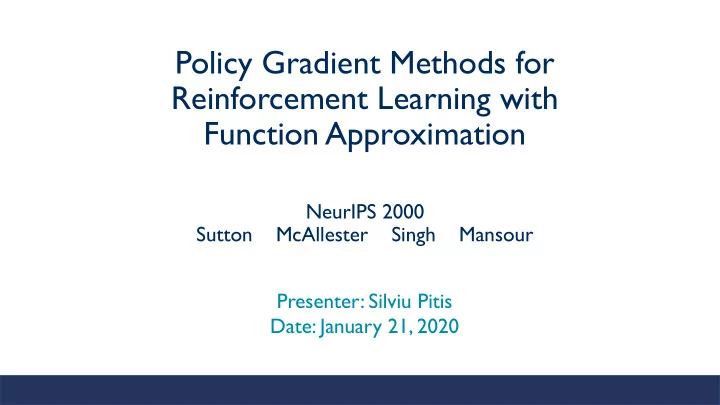

Policy Gradient Methods for Reinforcement Learning with Function Approximation NeurIPS 2000 Sutton McAllester Singh Mansour Presenter: Silviu Pitis Date: January 21, 2020
Talk Outline ● Problem statement, background & motjvatjon ● Topics: – Statement of policy gradient theorem – Derivatjon of policy gradient theorem – Actjon-independent baselines – Compatjble value functjon approximatjon – Convergence of policy iteratjon with compatjble fn approx
Problem statement We want to learn a parameterized behavioral policy: that optimizes the long-run sum of (discounted) rewards: note : the paper also considers the average reward formulation This is exactly the reinforcement learning problem! (same results apply)
Traditional approach: Greedy value-based methods Traditional approaches (e.g., DP, Q-learning) learn a value function : They then induce a policy using a greedy argmax:
T wo problems with greedy, value-based methods 1) They can diverge when using function approximation, as small changes in the value function can cause large changes in the policy In fully observed, tabular case, guaranteed to have an optimal deterministic policy. 2) Traditionally focused on deterministic actions, but optimal policy may be stochastic when using function approximation (or when environment is partially observed)
Proposed approach: Policy gradient methods ● Instead of actjng greedily, policy gradient approaches parameterize the policy directly, and optjmize it via gradient descent on the cost functjon: ● NB1: cost must be difgerentjable with respect to theta! Non-degenerate, stochastjc policies ensure this. ● NB2: Gradient descent converges to a local optjmum of the cost functjon → so do policy gradient methods, but only if they are unbiased!
Stochastic Policy Value Function Visualization Source: Me (2018)
Stochastic Policy Gradient Descent Visualization Source: Dadashi et. al. (ICLR 2019)
Unbiasedness is critical ● Gradient descent converges → so do unbiased policy gradient methods! ● Recall the defjnitjon of the bias of an estjmator: – An estjmator of has bias: – It is unbiased if its bias equals 0. ● This is important to keep in mind, as not all policy gradient algorithms are unbiased, so may not converge to a local optjmum of the cost functjon.
Recap ● Traditional value-based methods may diverge when using function approximation � directly optimize the policy using gradient descent Let’s now look at the paper’s 3 contributions: 1) Policy gradient theorem --- statement & derivation 2) Baselines & compatible value function approximation 3) Convergence of Policy Iteration with compatible function approx
Policy gradient theorem (2 forms) Recall the objective: Sutton 2000 NB : This is the true future value of the policy, not an approximation! Modern form
The two forms are equivalent (Sutton 2000) (Modern form)
Trajectory Derivation: REINFORCE Estimator “Score function gradient estimator” also known as “REINFORCE gradient estimator” --- very generic, and very useful! NB: R(tau) is arbitrary (i.e., can be non-differentiable!)
Intuition of Score function gradient estimator Source: Emma Brunskill
Trajectory Derivation Continued Almost in modern form! Just one more step...
Trajectory Derivation, Final Step Since earlier rewards do not depend on later actions. And this now (proportional to) modern form!
Variance Reduction If f(x) is positive everywhere, we are always positively reinforcing the same policy! If we could somehow provide negative reinforcement for bad actions, we can reduce variance... Source: Emma Brunskill
Variance Reduction If f(x) is positive everywhere, we are always positively reinforcing the same policy! If we could somehow provide negative reinforcement for bad actions, we can reduce variance... Source: Emma Brunskill
Last step: Subtracting an Action-independent Baseline I Source: Hado Van Hasselt
Last step: Subtracting an Action-independent Baseline II Source: Hado Van Hasselt
Compatible Value Function Approximation ● Policy gradient theorem uses an unbiased estimator of the future rewards, ● What if we use a value function to approximate ? Does our convergence guarantee disappear? ● In general, yes. ● But not if we use a compatible function approximator --- Sutton et al. Provides a sufficient (but strong) condition for a function approximator to be compatible (i.e., provide an unbiased policy gradient estimate).
Source: Russ Salakhutdinov
Source: Russ Salakhutdinov
Recap: Compatible Value Function Approx. ● If we approximate the true future reward with an approximator such that the policy gradient estimator remains unbiased � gradient descent converges to a local optimum. ● Sutton uses this this to prove the convergence of policy iteration when using a compatible value function approximator.
Critique I: Bias & Variance Tradeoffs ● Monte Carlo returns provide high variance estjmates, so we typically want to use a critjc to estjmate future returns. ● But unless the critjc is compatjble, it will introduce bias. ● “Tsitsiklis (personal communicatjon) points out that [the critjc] being linear in may be the only way to satjsfy the [compatjble value functjon approximatjon] conditjon.” ● Empirically speaking, we use non-compatjble (biased) critjcs because they perform betuer.
Critique II: Policy Gradients are On Policy ● The policy gradient theorem is, by defjnitjon, on policy . ● Recall : on-policy methods learn from dat that they themselves generate; ofg-policy methods (e.g., Q-learning) can learn from data produced by other (possibly unknown) policies. ● To use ofg-policy data with policy gradients, we need to use importance sampling, which results in high variance. ● Limits the ability to use data from previous iterates.
Recap ● Traditional value-based methods may diverge when using function approximation � directly optimize the policy using gradient descent ● We do this with the policy gradient theorem: ● Some key takeaways: ● REINFORCE log-gradient trick is very useful (know it!) ● We can reduce the variance by using a baseline ● There is thing called compatible approximation, but to my knowledge its not so practical ● IMO, the main limitation of policy gradient methods is their on-policyness (but see DPG!)
Recommend
More recommend